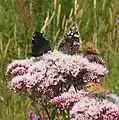Eupatorium cannabinum
Eupatorium cannabinum, commonly known as hemp-agrimony,[2] or holy rope,[3] is a herbaceous plant of the daisy family. It is a robust perennial native to many areas of Europe.[3][4] It is cultivated as an ornamental and occasionally found as a garden escape in scattered locations in China,[5] the United States and Canada.[6][7] It is extremely attractive to butterflies, much like buddleia.[8]
| Eupatorium cannabinum | |
|---|---|
.jpg.webp) | |
| IJmuiden, Netherlands | |
| Scientific classification | |
| Kingdom: | Plantae |
| Clade: | Tracheophytes |
| Clade: | Angiosperms |
| Clade: | Eudicots |
| Clade: | Asterids |
| Order: | Asterales |
| Family: | Asteraceae |
| Genus: | Eupatorium |
| Species: | E. cannabinum |
| Binomial name | |
| Eupatorium cannabinum | |
| Synonyms[1] | |
|
Synonymy
| |
If the genus Eupatorium is defined in a restricted sense (about 42 species), E. cannabinum is the only species of that genus native to Europe (with the remainder in Asia or North America).[9]
Description
Eupatorium cannabinum is a perennial herb up to 1.5 meters (4.9 feet) tall or more and 1.2 meters (3.9 feet) wide.[4] It lives in moist low-lying areas in temperate Eurasia. It is dioecious, with racemes of mauve flower heads which are pollinated by insects from July to early September. The flowers are visited by many types of insects, and can be characterized by a generalized pollination syndrome.[10] The flower heads are tiny, fluffy and can be pale dusty pink or whitish.[4] The fruit is an achene about 2 or 3 mm long, borne by a pappus with hairs 3 to 5 mm long, which is distributed by the wind. The plant over-winters as a hemicryptophyte.[9]
Toxicity
Eupatorium cannabinum contains tumorigenic pyrrolizidine alkaloids.[11] The alkaloids may be present in the plant material as their N-oxides.[12]
Pharmacology
E. cannabinum is used in the European traditional medicine as anti-inflammatory agent for respiratory tract diseases, and several of its sesquiterpene lactone constituents were identified to have anti-inflammatory effect in isolated human neutrophils, with the anti-inflammatory action of the sesquiterpene lactone eupatoriopicrin being verified also in mouse peritonitis model.[13]
- Subspecies
- Eupatorium cannabinum L. subsp. cannabinum - most of species range
- Eupatorium cannabinum L. subsp. corsicum (Req. ex Loisel.) P.Fourn. - Corsica, Sardinia, Basilicata, Apulia
References
- The Plant List, Eupatorium cannabinum L.
- "BSBI List 2007". Botanical Society of Britain and Ireland. Archived from the original (xls) on 2015-01-25. Retrieved 2014-10-17.
- Altervista Flora Italiana, Holy Rope, gewöhnlicher Wasserdost, hampflockel, Canapa acquatica includes photos and European distribution map
- "Botanica. The Illustrated AZ of over 10000 garden plants and how to cultivate them", p 359. Könemann, 2004. ISBN 3-8331-1253-0
- Flora of China, Eupatorium cannabinum Linnaeus, 1753. 大麻叶泽兰 da ma ye ze lan
- "Eupatorium cannabinum". Flora of North America.
- Biota of North America Program 2014 county distribution map
- Wildlife Trusts - Hemp Agrimony
- Schmidt, Gregory J.; Schilling, Edward E. (2000). "Phylogeny and biogeography of Eupatorium (Asteraceae: Eupatorieae) based on nuclear ITS sequence data". Am. J. Bot. 87 (5): 716–726. doi:10.2307/2656858. JSTOR 2656858. PMID 10811796.
- Van Der Kooi, C. J.; Pen, I.; Staal, M.; Stavenga, D. G.; Elzenga, J. T. M. (2016). "Competition for pollinators and intra-communal spectral dissimilarity of flowers". Plant Biology. 18 (1): 56–62. doi:10.1111/plb.12328. PMID 25754608.
- Fu, P.P., Yang, Y.C., Xia, Q., Chou, M.C., Cui, Y.Y., Lin G., "Pyrrolizidine alkaloids-tumorigenic components in Chinese herbal medicines and dietary supplements", Journal of Food and Drug Analysis, Vol. 10, No. 4, 2002, pp. 198-211
- Woerdenbag, H. J. (October 1986). "Eupatorium cannabinum L.". Pharmaceutisch Weekblad Scientific Edition. 8 (5): 245–251. doi:10.1007/bf01960068. ISSN 0167-6555. PMID 3537953. S2CID 26403365.
- Michalak, B; Piwowarski, JP; Granica, S; Waltenberger, B; Atanasov, AG; Khan, SY; Breuss, JM; Uhrin, P; Żyżyńska-Granica, B; Stojakowska, A; Stuppner, H; Kiss, AK (Feb 2019). "Eupatoriopicrin Inhibits Pro-inflammatory Functions of Neutrophils via Suppression of IL-8 and TNF-alpha Production and p38 and ERK 1/2 MAP Kinases". J Nat Prod. 82 (2): 375–385. doi:10.1021/acs.jnatprod.8b00939. PMID 30653318.
External links
| Wikimedia Commons has media related to Eupatorium cannabinum. |


